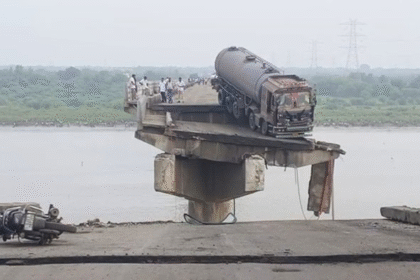Top 5 Shocking Impacts After Key Bridge in Arunachal Pradesh Washed Away by Torrential Rain
Arunachal Pradesh Reels Under Torrential Rains: Key Bridge Washed Away, Floods Displace Thousands Across 23 Districts
Dibang Valley / Itanagar:
The northeastern state of Arunachal Pradesh is grappling with a deepening humanitarian and infrastructural crisis following days of relentless rainfall that triggered massive floods and landslides across the region. Among the most alarming incidents was the collapse of a key suspension bridge in Dibang Valley district, which has left villagers stranded and cut off from vital resources, even as authorities scramble to mount relief and rescue efforts in the face of extreme weather conditions.
The deteriorating flood situation in the state has led to the death of at least 12 people, with two more still missing, as of Wednesday. More than 3,000 people have been affected across 23 of the state’s districts. Relief agencies and state officials are working round the clock to provide emergency support, deploying helicopters, boats, and drones in various operations.
Suspension Bridge Collapse in Dibang Valley Cuts Off Mawali Village
The crisis began to escalate late last week when a crucial two-foot-wide suspension bridge in Mawali village, located under the Etalin circle in Dibang Valley district, was washed away by surging waters of the Dri River. The bridge had served as a vital link for local residents, facilitating daily travel and communication between remote villages and administrative centres.
With the bridge now destroyed, six residents, including three children, were initially reported stranded. Officials from the district administration quickly launched a rescue operation on May 30. However, continued heavy rainfall and swollen river conditions made ground access impossible, forcing the authorities to explore aerial alternatives.
In an innovative but ultimately hindered attempt, the administration used drones to deliver cooked food packets to the stranded villagers. Yet, these efforts were largely thwarted by incessant rain and low visibility conditions, underlining the logistical and environmental challenges of operating in the remote and rugged terrain of the region.
Mawali is located approximately 139 kilometres from Anini, the administrative headquarters of Dibang Valley, highlighting the remoteness of the affected region and the urgent need for reliable infrastructure in such vulnerable areas.
On-the-Ground Assessment and Relief in Other Villages
Meanwhile, officials have also reported severe damage in the nearby villages of Athunli and Echanli, where flash floods and landslides — triggered by unrelenting rain — have caused widespread destruction. A team of state and district-level authorities visited these sites to assess the situation and deliver essential relief materials, including food supplies, medical aid, and temporary shelter materials.
Local accounts suggest that homes have been damaged, roads blocked by debris, and agricultural land submerged — setting the stage for long-term livelihood disruptions even after the immediate crisis passes.
Broader Impact Across Arunachal Pradesh: 23 Districts Affected
The catastrophe in Dibang Valley is only part of a much larger pattern of devastation across Arunachal Pradesh, which has been pummeled by intense monsoon rains since late May. The Indian Meteorological Department (IMD) has reported that cumulative rainfall levels in many districts are well above average, leading to swollen rivers, breached embankments, and collapsed infrastructure.
As of Wednesday, the flood situation remained severe, affecting over 3,000 residents across 23 of the state’s 25 districts. Among the worst-hit areas is Changlang district, where flash floods have inundated six villages, rendering over 2,200 people homeless. Emergency shelters have been established, but access continues to be a major challenge in several locations.
Changlang has also seen extensive damage to its road and bridge infrastructure. Flash floods washed away a significant portion of the Makantong bridge along the Trans-Arunachal Highway, cutting off critical connectivity between the towns of Miao and Bordumsa. Additionally, the Noa-Dehing River, swollen far beyond its usual levels, has overflowed into residential areas and destroyed vast tracts of farmland, particularly in the Dharmapur block under the Namphai circle.
Rising Death Toll and Ongoing Search Operations
The human toll of the floods and landslides continues to mount. According to state officials, at least 12 people have died in rain-related incidents, with search operations underway for at least two others who are reported missing.
The East Kameng district recorded the highest fatalities, with seven people losing their lives due to landslides and collapsing structures. Two deaths were reported from Lower Subansiri, while one fatality each occurred in the districts of Longding, Lohit, and Anjaw.
The casualties have prompted the state government to intensify its coordination with national disaster management agencies, including the National Disaster Response Force (NDRF) and the Indian Air Force (IAF). Helicopters are being deployed to airdrop supplies and, where possible, evacuate critically affected populations from isolated villages.

Use of Drones and Air Support in Relief Operations
The use of drones to deliver supplies in Dibang Valley, despite facing obstacles, underscores how technology is being harnessed to respond to natural disasters in hard-to-reach areas. Drones were deployed for aerial surveys and to deliver food packets in locations where road access was impossible. While weather conditions continue to hamper their effectiveness, the initiative represents a shift toward more adaptable and rapid-response capabilities.
IAF helicopters have also played a pivotal role in the ongoing relief efforts, particularly in areas where the terrain is too challenging for ground transport. Combined with support from boats operated by local and regional authorities, these aerial efforts are essential in preventing a deeper humanitarian disaster.
Coordination with Central Agencies and Long-Term Concerns
The state government is closely coordinating with central agencies to address the multifaceted crisis. Officials from the National Disaster Management Authority (NDMA) are on the ground assessing both the immediate needs and the structural vulnerabilities exposed by the disaster.
One growing concern is the long-term impact on agricultural and horticultural output. Several districts, including Changlang and Anjaw, have reported significant damage to standing crops, fruit plantations, and irrigation systems. If not addressed swiftly, this could create a secondary wave of economic hardship for already affected populations.
Climate Change and Infrastructure Vulnerability in the Northeast
This episode once again underscores the acute vulnerability of northeastern India to climate-induced disasters. Arunachal Pradesh, with its mountainous terrain and fragile ecosystems, is especially prone to landslides, flash floods, and infrastructure failures during the monsoon season.
Experts have noted that climate variability is increasing both the frequency and intensity of rainfall events in the region. Combined with underdeveloped infrastructure and limited early-warning mechanisms in remote districts, this creates a high-risk scenario for both residents and emergency responders.
The loss of key infrastructure, like the suspension bridge in Mawali and the partial collapse of the Makantong bridge on the Trans-Arunachal Highway, serves as a stark reminder of the urgent need to climate-proof critical connectivity networks. Resilience must be built into the development model for northeastern states, integrating both traditional knowledge and modern engineering to adapt to shifting climatic patterns.
Government Response and Public Appeal
Chief Minister Pema Khandu has been monitoring the situation closely and has appealed for calm while assuring the public that all necessary resources are being mobilized. The state government is expected to announce a comprehensive relief package for affected families, including financial compensation for the bereaved and support for reconstruction in devastated villages.
In a press statement, the Chief Minister said:
“We are working in tandem with the central government and national agencies to ensure that every citizen receives help. Our priority is to save lives, restore connectivity, and support communities in rebuilding stronger.”
Local administrations have been urged to open 24/7 helplines, set up additional relief camps, and prepare for further contingencies as the rains continue. The IMD has issued warnings of continuing precipitation in the coming days, urging residents in vulnerable zones to take precautions and avoid unnecessary travel.
Conclusion: A Call for Resilience and Reform
The ongoing crisis in Arunachal Pradesh is a wake-up call for long-term disaster preparedness in India’s northeastern frontier. As climate change continues to make extreme weather events more common, governments at all levels must rethink development through the lens of resilience.
While the dedication of rescue teams and the use of new technologies like drones and helicopters provide hope, the events of this week show that infrastructure built for fair-weather conditions will not survive in a world of intensifying climate extremes. The bridge that collapsed in Mawali was more than just a structure — it was a lifeline, and its loss highlights both a literal and symbolic break in our preparedness.
As Arunachal Pradesh continues to recover, the lessons from this disaster must inform future investments, not just in concrete and steel, but in forecasting, preparedness, and equitable development for all.
Also Read : 7 Powerful Reasons Why India Is Urging FATF to Recognise UPI Payments as a Global Financial Standard








